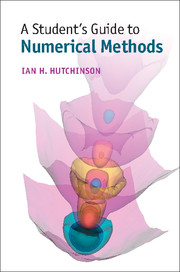Book contents
- Frontmatter
- Dedication
- Contents
- Preface
- 1 Fitting functions to data
- 2 Ordinary differential equations
- 3 Two-point boundary conditions
- 4 Partial differential equations
- 5 Diffusion. Parabolic partial differential equations
- 6 Elliptic problems and iterative matrix solution
- 7 Fluid dynamics and hyperbolic equations
- 8 Boltzmann's equation and its solution
- 9 Energy-resolved diffusive transport
- 10 Atomistic and particle-in-cell simulation
- 11 Monte Carlo techniques
- 12 Monte Carlo radiation transport
- 13 Next steps
- Appendix A Summary of matrix algebra
- References
- Index
Preface
Published online by Cambridge University Press: 05 May 2015
- Frontmatter
- Dedication
- Contents
- Preface
- 1 Fitting functions to data
- 2 Ordinary differential equations
- 3 Two-point boundary conditions
- 4 Partial differential equations
- 5 Diffusion. Parabolic partial differential equations
- 6 Elliptic problems and iterative matrix solution
- 7 Fluid dynamics and hyperbolic equations
- 8 Boltzmann's equation and its solution
- 9 Energy-resolved diffusive transport
- 10 Atomistic and particle-in-cell simulation
- 11 Monte Carlo techniques
- 12 Monte Carlo radiation transport
- 13 Next steps
- Appendix A Summary of matrix algebra
- References
- Index
Summary
This book presents what every graduate-level physicist and engineer should know about solving physical problems by computer.
Hardly any research engineer or scientist, whatever their speciality, can do without at least minimal competence in computational and numerical methods. It helps the practitioner greatly to appreciate the big picture of how computational techniques are applied. A book like this that covers the breadth of the methods, with a minimum of fuss, serves the purpose of acquiring the essential knowledge. It is derived from an accelerated short course for entering graduate students in the MIT Department of Nuclear Science and Engineering. That's why some examples used to illustrate the numerical techniques are drawn from nuclear science and engineering. But no specific background nuclear knowledge is required. The mathematical and computational techniques explained are applicable throughout a whole range of engineering and physical science disciplines, because the underlying numerical methods are essentially common.
For so short a course, a great deal of background must be taken for granted, and a lot of relevant topics omitted. The brevity is not a fault though; it is an intention. And while there is an enormous range of material that could be added, I see the deliberate selection as a merit. This approach, I believe, enables a student to read the text sequentially, experience rapid progress, and work to master the content. Of course the present approach contrasts strongly both with comprehensive textbooks and with handbooks. Massive teaching textbooks, in addition to providing vastly more detail, cover topics such as standard matrix inversion or decomposition, and elementary quadrature. Those can mostly be taken for granted today, I believe, because of widespread use of mathematical computing systems. Large textbooks also often approach the topics by a roundabout set of examples and develop the mathematics in a more elementary and drawn-out style. Doubtless that approach has merit, but it requires much more time to get to the heart of the matter.
- Type
- Chapter
- Information
- A Student's Guide to Numerical Methods , pp. xi - xivPublisher: Cambridge University PressPrint publication year: 2015

